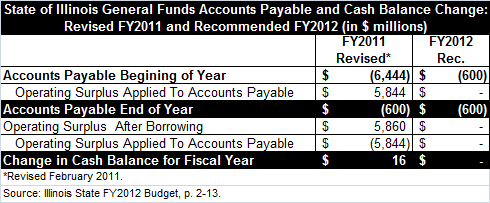February 17, 2011
Governor Pat Quinn’s proposed FY2012 budget for the State of Illinois features additional borrowing and an overall increase in spending, despite steep spending reductions in the area of human services.
The Governor’s FY2012 budget, issued on February 16, 2011, includes total operating resources of $33.9 million and total expenditures of $35.4 billion. In order to close the operating shortfall, the Governor’s plan uses $1.45 billion of the proceeds from a proposed $8.75 billion borrowing in FY2011.
The $8.75 billion borrowing plan, which has not been approved by the General Assembly, involves the sale of 15-year General Obligation (GO) Restructuring Bonds. Besides the $1.45 billion to be used in FY2012, the Governor plans to use $4 billion of the proceeds in FY2011 to help pay down the State’s $6.4 billion backlog of unpaid bills to vendors and local governments. The rest of the proceeds—roughly $3.3 billion—is intended to be used to reduce the $1.4 billion backlog of corporate tax refunds and the $1.1 billion backlog of state employee healthcare bills and to generate more federally reimbursable expenses in the Medicaid program.
This discussion of the FY2012 budget focuses on General Funds. General Funds, the largest component of the State’s operating budget, support the regular operating and administrative expenses of most state agencies. The state budget also includes Other State Funds, which are restricted to revenues and expenditures of a specific source. Federal Funds are revenues from the federal government (other than those designated for General Funds) that support a variety of state programs. The Governor’s total FY2012 budget, including all the funds, is $52.7 billion.
The chart below shows a 10.8% increase in FY2012 General Funds operating resources to $33.9 billion from $30.6 billion in FY2011. The FY2012 budget included a revised version of the FY2011 budget. The increase in operating resources in FY2012 is due to a rise of $4.6 billion in state tax revenues, reflecting the first full year of revenue collection since the January 2011 enactment of higher personal and corporate income tax rates. As previously discussed on this blog, personal income tax rates were increased from 3% to 5% effective on January 1, 2011 and corporate tax rates were increased from 4.8% to 7%. The increases are scheduled to start being rolled back on January 1, 2015. Illinois corporations also pay a 2.5% Personal Property Replacement Tax.
The projected increase in state revenues in FY2012 is expected to be partially offset by a $662 million decline in federal revenues. Federal revenues are expected to drop partly because of the end of federal stimulus funding on June 30, 2011 that had been provided under the American Recovery and Reinvestment Act of 2009.
Total General Funds expenditures in FY2012 are expected to increase by $1.7 billion, or 5.1%, from $33.7 billion in FY2011 to $35.4 billion in FY2012. The increase is mainly due to an increase of $1.6 billion, or 6.7%, in net appropriations from $24.3 billion in FY2011 to $25.9 billion in FY2012. Net appropriations subtract out appropriations that remain unspent because they are held back at the Governor’s direction, because expenses do not reach budgeted levels or because checks issued by the State have not been cashed. The state’s statutorily required contributions to its pension funds are also expected to increase by $675 million, or 17.2%, from $3.9 billion in FY2011 to $4.6 billion in FY2012.
The appropriations increase in FY2012 is partly due to a more than doubling of General Funds appropriations for the state’s employee health insurance program from $691.1 million in FY2011 to $1.4 billion in FY2012. The State had appropriated far less than needed to the group insurance program in FY2011, leading to the growth in unpaid medical claims.
However, the General Funds budget of the Department of Human Services is expected to decline by $388.5 million, or 10.6%, from $3.7 billion in FY2011 to $3.3 billion in FY2012. Many healthcare providers will have state-paid rates reduced by 6% and many grants to social service agencies will be cut by 20%, Human Services Director Michelle Saddler said at a briefing in Springfield after the budget was issued.
The Governor also plans to save $107 million by eliminating Illinois Cares Rx, a state-funded program that does not receive federal reimbursement under Medicaid. Illinois Cares Rx is a prescription drug program that supplements coverage for seniors in Medicare Part D. Seniors in the program do not qualify for Medicaid because their income levels exceed federal limits.
Under the Governor’s revised FY2011 budget, the State would borrow $8.9 billion for operations and end the year with a total deficit of roughly $453 million. After using $1.45 billion of borrowing in FY2012, the deficit would remain at the same level.
The next chart shows how the Governor’s budget plans for FY2011 and FY2012 would affect the State’s General Funds accounts payable. After using $5.84 billion of the FY2011 operating surplus to reduce the $6.4 billion backlog of unpaid bills, the state would be left with $600 million of accounts payable and cash reserves would increase by $16 million. Unpaid bills are projected to remain at $600 million at the end of FY2012.


